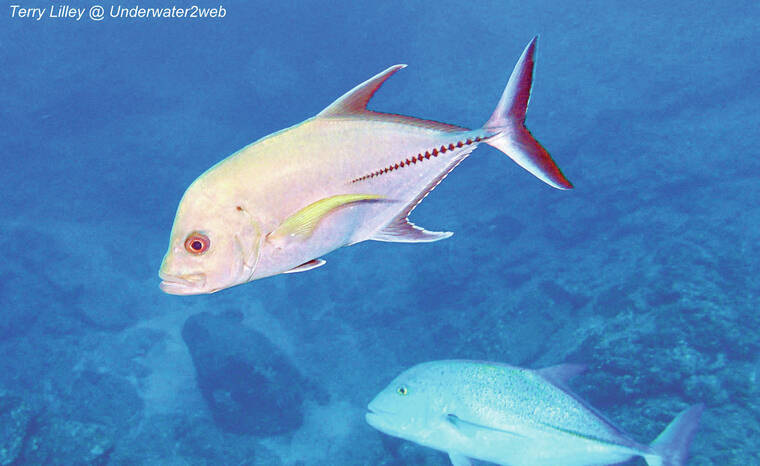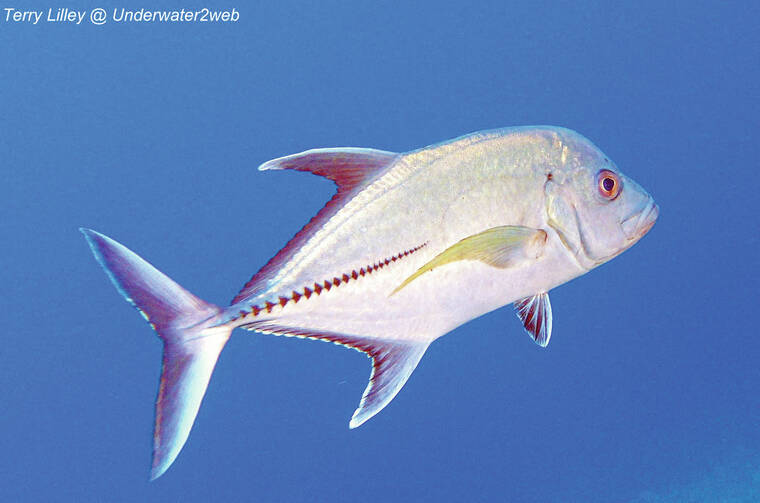Here in the main Hawaiian Islands, we often see ‘omilu the bluefin trevally and ulua aukea the giant trevally.
Most people don‘t know that we also have several other species of large jacks that are common in the Northwest Hawaiian Islands, but rare in the main islands. These include ulua the barred jack, ulua the island jack, ulua kihikihi the threadfin jack, pake ulua the bigeye trevally, and ulua pa‘opa‘o the golden trevally ulua la‘uli the black jack!
These large jack species are often misidentified because they all look similar and behave the same. What even makes it more difficult to identify is their babies look very similar and often all hang out together until they are a few years old. Fisherman know the young jacks as papio, but a school of papio can have several different species.
While scuba diving in Ni‘ihau, I shot video of a big, 30-inch-long trevally that had black fins versus gray or blue fins, and I was not sure at first what jack species I was filming. It turned out to be ulua la‘uli the black jack. There are many fish species that like cooler water so they live primarily in the NW Hawaiian Islands.
Other species like warmer water so they live more toward Hawai‘i Island where the water is warmer. Kaua‘i and Ni‘ihau have the coolest water of the main Hawaiian Islands, so we often get the cold-water species mixed with the warm-water species, which can make identification difficult. DNA testing has shown that Kaua‘i may even have crossbreeds that may be a totally different species!
The black jack has black fins, a black lateral line and a black dot right above the gill cover. Since I have only seen one of these jacks out of 3,000 scuba dives in Hawai‘i, I never was able to observe its behavior. The black jack lives all throughout the tropical Pacific, so when I went to the Galapagos Islands I was surprised to see several black jacks.
Recently, I went on a dive trip to Socorro Island, which is 300 miles out into the sea off of Cabo San Lucas, Mexico, and was blown away because I shot video of over 100 large black jacks, so I finally got to study their behavior. Socorro Island is way out in the middle of the Pacific, and due to the deep water upwelling, the water is much colder than in Hawai‘i.
Ulua la‘uli have completely different behavior than any other large jack I have seen. When you go diving they follow you around so close you can reach out and touch them.
Other large jack species will normally move away from divers. The black jacks were also swimming right under the giant manta rays and large sharks. They seem to swim close to larger animals to draft, like a person on a bike may follow a bus on the road to save energy.
When the black jack wants to move from place to place to hunt small fish, it catches a ride so it does not need to spend so much energy to travel. I have not seen any other jack species do this.
You can see the black jacks in action in my new Socorro marine life movie up on my YouTube at Underwater2web, which even has one ulua la‘uli that is swimming right in the mouth of a huge manta ray to get a free ride!
•••
Terry Lilley is a marine biologist living in Hanalei Kaua‘i and co-founder of Reef Guardians Hawai‘i, a nonprofit on a mission to provide education and resources to protect the coral reef. To donate to Reef Guardians Hawaii go to www.reefguardianshawaii.org.



